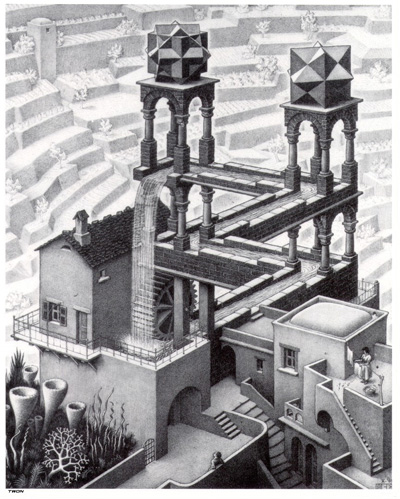- Waterfall (M. C. Escher)
Artwork

title=Waterfall
artist=M. C. Escher
year=1961
type=lithograph
height=38
width=30"Waterfall" is a lithograph print by the Dutch artist
M. C. Escher which was first printed in October,1961 . It shows an apparentparadox where water from the base of awaterfall appears to run uphill before reaching the top of the waterfall.While most two-dimensional artists use relative proportions to create an illusion of depth, Escher here and elsewhere uses conflicting proportions to create the visual paradox. Waterfall has the structure of a
Penrose triangle , animpossible object designed independently byRoger Penrose andOscar Reutersvärd .Description
The image depicts a village or part of a small city with an elevated
aqueduct andwaterwheel as the main focus. The aqueduct begins at the waterwheel and flows behind it. The walls of the aqueduct step downward, suggesting that it slopes downhill. The aqueduct turns sharply three times, first to the left, then straight forward and finally to the left again. We are looking down at the scene diagonally, which means that from our perspective the aqueduct appears to be slanted upward. We are also looking across it diagonally from the lower right, which means from our perspective the two left-hand turns are directly in line with each other, while the waterwheel, the forward turn and the end of the aqueduct are all in line. The second left-hand turn is supported by pillars from the first, while the other two corners are supported by a tower of pillars that begins at the waterwheel. The water falls off the edge of the aqueduct and over the waterwheel in an infinite cycle. (In his notes on the picture, Escher points out that some water must be periodically added to this apparentperpetual motion machine to compensate forevaporation .) The two support towers continue above the aqueduct and are topped by two compoundpolyhedra . The one on the left is acompound of three cubes . The one on the right is astellation of arhombic dodecahedron (or a compound of three non-regular octahedra).Below the mill is a garden of bizarre, giant plants. This is actually a magnified view of a cluster of
moss andlichen which Escher drew in ink as a study in1942 .The background seems to be an endlessly climbing expanse of terraced farmland.
Wikimedia Foundation. 2010.
